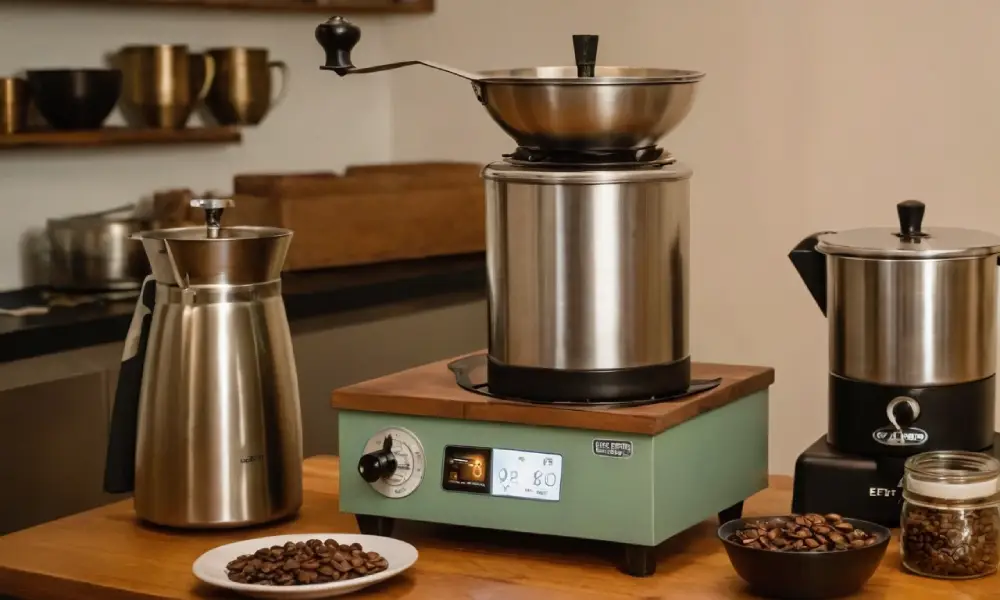At Regency Cafe, we understand that the pursuit of the perfect cup of coffee is a deeply personal one.
Whether you’re a coffee enthusiast, hobbyist, or just someone looking to save a bit of money, roasting your own coffee beans can be an exciting and rewarding journey.
But before you dive into the world of home roasting, it’s important to know what equipment works best, what methods are available, and the benefits you’ll get from roasting your beans yourself.

Why Roast Coffee at Home?
There are several reasons why people choose to roast their own beans.
Here’s a quick rundown of the main benefits:
- Freshness: Roasting your own beans means you control when they’re roasted, which translates to fresher coffee.
- Personalization: Home roasting lets you experiment with different roast levels, allowing you to tailor your coffee to your exact taste.
- Cost Savings: While buying a roaster might seem expensive upfront, green beans are typically cheaper than pre-roasted ones. Plus, you can buy in bulk to save even more.
- Hobby: Roasting coffee is a fun and rewarding hobby. There’s something satisfying about knowing you made your coffee from scratch.
But before you rush out to buy a roaster, let’s dive into the practical side of things.
What You Need to Roast Coffee at Home
Here are the key items you’ll need for home roasting:
| Item | Purpose | Best For |
|---|---|---|
| Coffee Roaster | The main piece of equipment for roasting beans. | Those who want consistent results. |
| Pan/Popcorn Popper | Budget-friendly roasting methods. | Beginners or those on a tight budget. |
| Thermometer | Helps track temperatures during roasting. | Ensuring precise control. |
| Cooling Tray | Cools beans quickly after roasting to preserve flavor. | All roasters, especially for flavor. |
| Coffee Beans | Unroasted, green beans (the starting point). | Anyone starting out in home roasting. |

Methods of Home Coffee Roasting
There are a few ways to roast coffee at home, each with its own pros and cons.
Let’s break them down.
1. Electric Drum Roasters
Electric drum roasters like the Turin Legato and Mii Coffee Apex have become popular choices for home roasters. These machines use rotating drums to ensure uniform roasting and can handle larger batches than other methods.
Pros:
- Consistent and easy-to-use.
- Good for beginners and more experienced roasters.
- Provides control over the roasting process.
Cons:
- Can be expensive.
- Larger machines take up more space.
2. Popcorn Poppers
Popcorn poppers are a popular budget option for those new to home roasting. Some models, like the Severin 117803, have vents and solid bottoms that allow for roasting.
Pros:
- Low cost.
- Can be a fun DIY project to modify.
- Works well for small batches.
Cons:
- Limited control over the roasting process.
- Small batch size (you may need to roast multiple times).
3. Pan Roasting
If you’re looking to roast on a budget, a non-stick pan and a heat source could be your best friend. Many home roasters start here because it’s simple and doesn’t require much equipment.
Pros:
- Very cheap option.
- Gives you the flexibility to try different techniques.
Cons:
- Messy, especially when it comes to chaff.
- Less control over roast consistency.
4. DIY Drum Roasters
For those who like a challenge, you can build your own drum roaster using a metal drum, a heat source, and a motor (or a hand drill).
Pros:
- Low-cost entry (if you have the tools).
- Completely customizable.
Cons:
- Requires technical knowledge.
- Less control and consistency compared to store-bought roasters.
The Roast Process: Key Phases You Should Know
No matter what method you use, understanding the roasting process is crucial for getting the best results. Here are the key phases:
- Endothermic Phase: The beans start heating up.
- First Crack: The beans expand and crack open. This is when the roast really begins.
- Development Phase: This is where the flavor begins to deepen. The time spent here can affect the roast’s taste.
- Second Crack: The beans crack again, signaling a deeper roast. For darker roasts, this is the sweet spot.

Why Does Equipment Matter?
While it’s entirely possible to roast coffee beans in a pan or popcorn popper, investing in a higher-end roaster offers several advantages:
- Consistency: A drum roaster or other specialized equipment gives you more control over the temperature and roast profile, leading to more consistent results.
- Flavor: Better equipment helps you avoid under-roasting or burning the beans, which can ruin the flavor.
- Time Efficiency: Dedicated roasters save you time and effort compared to constantly watching a pan or modifying a popcorn popper.
Is Home Roasting for You?
Home coffee roasting isn’t for everyone, but it offers several benefits for those willing to put in the time and effort. Here are a few things to think about before you jump in:
- Time Commitment: Roasting takes time, especially when you’re learning.
- Learning Curve: It’s not an instant process. You’ll need to practice to perfect your roast.
- Cost vs. Convenience: While it might save you money in the long run, buying pre-roasted beans is much more convenient.
For some, home roasting will become a passion, while for others, it might remain an occasional hobby.
Either way, it’s an experience that will deepen your understanding of coffee and give you a new appreciation for what goes into that perfect cup.
Conclusion
Whether you’re seeking to save a bit of money, discover new flavors, or just enjoy the process of crafting your coffee, roasting at home offers a range of possibilities.
From small-scale methods like popcorn poppers to more sophisticated electric drum roasters, there’s something for everyone.
The key is to find the method that works for you, and most importantly, enjoy the journey!
At Regency Cafe, we believe that good coffee starts with good beans, and roasting your own can elevate your coffee experience to new heights. Happy roasting!




